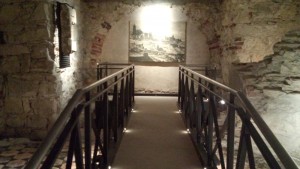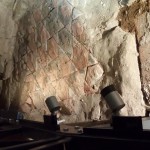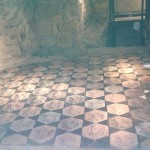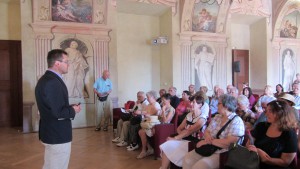Another crucial stage of the Preservation Project of St. Wenceslas Rotunda in Prague’s Lesser Town Square was concluded with the final approval that took place at the end of June.
As part of the construction work, a metal footbridge has been installed allowing the visitors to take a look around the area formally occupied by the Rotunda. Thanks to the replicas of the original tiles laid out in it, they will also get a better picture of the Rotunda’s original overall size and dimensions. Archaeological research that testifies to the uniqueness of the whole discovery is likewise coming to a close.
Reconstructed interior of the Rotunda
A replica of the 11th century tiling has been laid in its original position inside the Rotunda. These 290 tiles of three shapes make up ¼ of the flooring area of the Rotunda, and match the original fragment of the historical tiling forming nearly 5% of the overall ground surface. A fragment of a Romanesque window frame is also displayed inside the Rotunda. A stone circle from an even earlier structure made of wooden stakes can also be seen here.
In the course of their research, the archaeologists have documented a jewellery collection dating back to the 9th and 10th centuries, six skeletons belonging to a knight’s family from the era of John of Bohemia and more than 3,000 pottery fragments. All these findings have transformed the space undiscovered by experts until only recently into one of the most significant archaeological sites in Prague. The Rotunda was in fact considered vanished for more than 300 years before it was accidentally discovered twelve years ago, during the reconstruction of the FMP CU building which is currently the seat of the Faculty’s IT department.
Over the summer, a holographic projection will be installed, and information boards complemented by an interactive presentation will be finished. A selection of exhibits will be situated in display cases before the Rotunda’s entrance. The Rotunda will be officially unveiled during an opening ceremony which will take place three months after the final building approval, on Czech Statehood Day celebrating St. Wenceslas. And so after almost 400 years it will witness yet another Wenceslavian miracle.
Reconstruction, archaeological, and restoration work on the Rotunda has been financed from the Norway Grants project. However, nearly 600 donors have so far supported the Preservation Project financially via the online application http://www.nase-rotunda.cz/en. The amount of 200 000 CZK is still left to be collected before the goal of 2,4 million CZK is reached and the Rotunda can be occasionally made accessible to wider public.
Fragment of the original tiling found in-situ
Replica of the historical tiling




